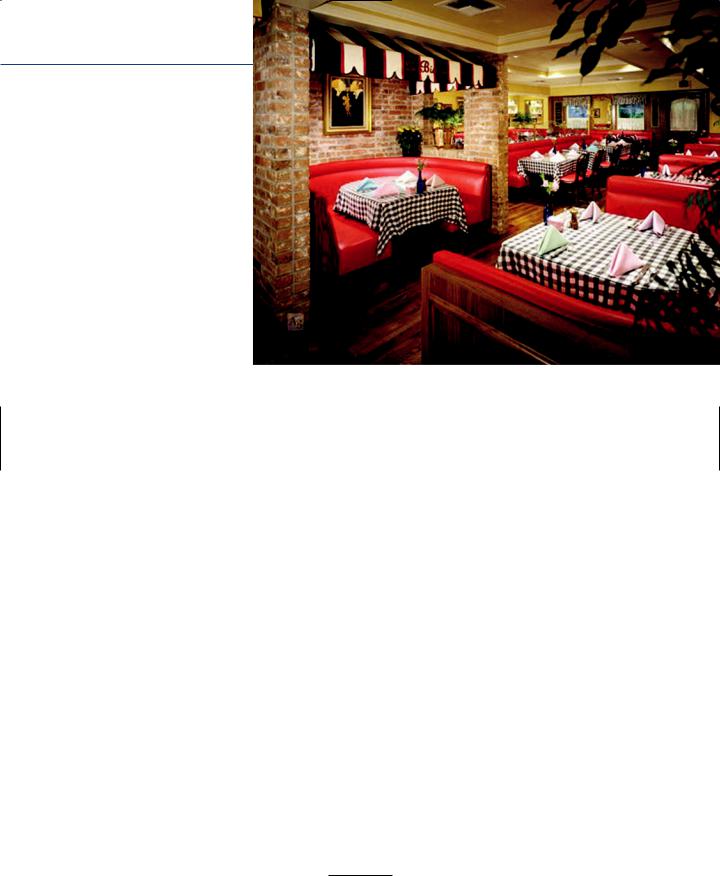
- •CONTENTS
- •PREFACE
- •Content—Benefits for Students
- •Content—Benefits for Instructors
- •Features of the Book for Students and Instructors
- •Supplementary Materials
- •Acknowledgments
- •What Is Hospitality Management?
- •The Manager’s Role in the Hospitality Industry
- •Why Study in a Hospitality Management Program?
- •Planning a Career
- •Employment as an Important Part of Your Education
- •Getting a Job
- •Employment at Graduation
- •The Outlook for Hospitality
- •Summary
- •Managing Change
- •Demand
- •Supply
- •Workforce Diversity
- •The Impact of Labor Scarcity
- •Summary
- •The Varied Field of Food Service
- •The Restaurant Business
- •The Dining Market and the Eating Market
- •Contemporary Popular-Priced Restaurants
- •Restaurants as Part of a Larger Business
- •Summary
- •Restaurant Operations
- •Making a Profit in Food Service Operations
- •Life in the Restaurant Business
- •Summary
- •Chain Restaurant Systems
- •Independent Restaurants
- •Franchised Restaurants
- •Summary
- •Competitive Conditions in Food Service
- •The Marketing Mix
- •Competition with Other Industries
- •Summary
- •Self-Operated Facilities
- •Managed-Services Companies
- •Business and Industry Food Service
- •College and University Food Service
- •Health Care Food Service
- •School and Community Food Service
- •Other Segments
- •Vending
- •Summary
- •Consumer Concerns
- •Food Service and the Environment
- •Technology
- •Summary
- •The Evolution of Lodging
- •Classifications of Hotel Properties
- •Types of Travelers
- •Anticipating Guest Needs in Providing Hospitality Service
- •Service, Service, Service
- •Summary
- •Major Functional Departments
- •The Rooms Side of the House
- •Hotel Food and Beverage Operations
- •Staff and Support Departments
- •Income and Expense Patterns and Control
- •Entry Ports and Careers
- •Summary
- •The Economics of the Hotel Business
- •Dimensions of the Hotel Investment Decision
- •Summary
- •The Conditions of Competition
- •The Marketing Mix in Lodging
- •Product in a Segmented Market
- •Price and Pricing Tactics
- •Place—and Places
- •Promotion: Marketing Communication
- •Summary
- •The Importance of Tourism
- •Travel Trends
- •The Economic Significance of Tourism
- •The United States as an International Tourist Attraction
- •Businesses Serving the Traveler
- •Noneconomic Effects of Tourism
- •Summary
- •Motives and Destinations
- •Mass-Market Tourism
- •Planned Play Environments
- •Casinos and Gaming
- •Urban Entertainment Centers
- •Temporary Attractions: Fairs and Festivals
- •Natural Environments
- •On a Lighter Note. . .
- •Summary
- •Management and Supervision
- •The Economizing Society
- •The Managerial Revolution
- •Management: A Dynamic Force in a Changing Industry
- •What Is Management?
- •Summary
- •Why Study Planning?
- •Planning in Organizations
- •Goal Setting
- •Planning in Operations
- •The Individual Worker as Planner
- •Long-Range Planning Tools
- •Summary
- •Authority: The Cement of Organizations
- •Departmentalization
- •Line and Staff
- •Issues in Organizing
- •Summary
- •Issues in Human-Resources Management
- •Fitting People to Jobs
- •Recruiting
- •Selection and Employment
- •Training
- •Retaining Employees
- •Staff Planning
- •Summary
- •The Importance of Control
- •Control and the “Cybernetic Loop”
- •Tools for Control
- •Summary
- •Leadership as Viewed by Social Scientists
- •Why People Follow
- •Leadership Theories
- •Communication
- •The Elements of Leading and Directing
- •Developing Your Own Leadership Style
- •Summary
- •A Study of Service
- •Rendering Personal Service
- •Managing the Service Transaction
- •How Companies Organize for Service
- •Summary
- •INDEX

136 |
Chapter 5 Restaurant Industry Organization |
60 |
|
|
|
|
|
|
|
|
|
|
|
|
|
50 |
|
|
|
|
|
|
|
|
|
|
|
|
|
40 |
|
|
|
|
|
|
|
|
|
|
|
|
|
30 |
|
|
|
|
|
|
|
|
|
|
|
|
|
20 |
|
|
|
|
|
|
|
|
|
|
|
|
|
10 |
|
|
|
|
|
|
|
|
|
|
|
|
|
0 |
|
|
|
|
|
|
|
|
|
|
|
|
|
1975 |
1980 |
1985 |
1989 |
1992 |
1996 |
1998 |
1999 |
2000 |
2001 |
2002 |
2003 |
2004 |
2005 |
Figure 5.1
Market share of 100 largest U.S. restaurant chains. (Source: Data from Technomic Inc., Chicago.)
sales in the United States, up from less than 33 percent in the early 1970s.6 What is particularly interesting, though, is that the chains’ market share growth seems to be slowing, increasing less than 1 percent in the most recent year reported.
Because successful chains usually have deep pockets (i.e., adequate financial reserves), they are able to ride out recessions. Indeed, some larger chains look on a recession as a time when they can purchase smaller or less successful chains having trouble weathering the economic storm. Although most experts agree that the concentration of chains will continue, fierce competition from regional chains (note the numerous examples used throughout this book), shifting consumer preferences, and competitive patterns will ensure that few, if any, players will establish anything resembling market dominance except on a local or temporary basis.
Independent Restaurants
Although chains undeniably have advantages in the competitive battle for the consumer’s dollar, independent restaurants also enjoy advantages that will ensure them a continuing place in the market—a place different from that of the chains,
perhaps, but significant nevertheless. It is also important to remember that many of the successful independent restaurants of today represent the chains of tomorrow.
OPERATING ADVANTAGES
We can use the same method to analyze the strengths of the independents that we used to examine the chain specialty restaurants. The advantages of the chains derive basically from the large size of their organization. The advantages of the independent

Independent Restaurants |
137 |
derive from a somewhat different common core but in many ways also claim size as their advantage. The independent’s flexibility, the motivation of its owner, and the owner’s presence in the operation affect its success.
In large organizations, a bureaucracy must grow up to guide decision making. Although this is a necessary—and in some ways healthy—development, it does result in a slower and more impersonal approach to problem solving in larger organizations.
In contrast, to survive and prosper, the independent must achieve differentiation: The operation must have unique characteristics in its marketplace that earn consumers’ repeat patronage. Flexibility and a highly focused operation, then, are the independent’s edge. Differentiation is the independent’s imperative.
Although the following analysis does not deal directly with the issue, we should note that economies of scale are important in the independent restaurant also. The small operation, the mom-and-pop restaurant, finds itself increasingly pressed by rising costs. We cannot specify a minimum volume requirement for success, but National Restaurant Association (NRA) figures show that in each size grouping, the restaurants with higher total sales achieve not only a higher dollar profit but a higher percentage of sales as profit.
MARKETING AND BRAND RECOGNITION
Ronald McDonald may be a popular figure, but he is not a real person (even though he has been named Chief Happiness Officer). The successful restaurant proprietor, however, is real. In fact, successful restaurateurs often become well known, are involved in community affairs, and establish strong ties of friendship with many of their customers. You can probably think of a local restaurant operator that fits this very profile. In a sense, they take on celebrity status. This local “celebrity” can be especially effective in differentiating the operation in the community, generally being visible, greeting guests by name as they arrive, moving through the dining room recognizing friends and acquaintances, dealing graciously with complaints, and expressing gratitude for praise. “Thanks and come back again” has an especially pleasant ring when it comes from the boss—the owner whose status in the town isn’t subject to corporate whim or sudden transfer.
Although the chain may have advantages among transients, the operator of a highquality restaurant enjoys an almost unique advantage in the local market. Moreover, word-of-mouth advertising may spread his or her reputation to an even larger area. The key to recognition for the independent is more than just personality; it is, first and foremost, quality.
Chains clearly have the advantage when it comes to advertising because of their national or regional advertising. This can create brand recognition. In contrast to chains,

138Chapter 5 Restaurant Industry Organization
however, many independents spend relatively little on paid advertising, relying instead on personal relationships, their reputation, and word of mouth. Moreover, independents begin with an advantage that chain units must work very hard to achieve: local identity.
SITE SELECTION
The chain operation continually faces the problem of selecting the right site as it seeks new locations for expansion. It may seem that site selection would not be a problem for an independent operation because that operation is already in place. On the other hand, successful independents sometimes expand by moving to a newer and larger location or by adding locations. These may be full-scale operations or, quite commonly in recent years, scaled-down versions such as the PODs discussed in Chapter 3. Another occasion when independents need to make location decisions is when evolving urban patterns and real-estate values change a location’s attractiveness. In some cases, a neighborhood goes into decline, bringing a threatening environment that is unattractive to guests. Alternatively, a restaurant may have a lease (rather than outright ownership) in an area that has become too attractive—at least in terms of rising rents. When the lease comes up for renewal, the owner may decide to move.
When the topic of relocation or adding a location arises, however, the independent operator begins with her or his own knowledge of the area and can add to that by hiring one of the consulting firms that specialize in location analysis. This can be an expensive service, but such services are generally available and the added expense will probably be worthwhile.
ACCESS TO CAPITAL
In most cases, chains will have the readiest access to capital. Sources of capital, however, are also available to small businesses. As noted earlier, banks are often hesitant to lend to restaurants because they are viewed as high-risk enterprises (although their willingness tends to move in cycles just like everything else). On the other hand, if an operator has a well-established banking relationship and a carefully worked-out business plan covering a proposed expansion, the local bank may be happy to make the loan.
The bank, however, is more likely to become involved if the operator can gain support from the U.S. Small Business Administration (SBA). Participation by the SBA does not eliminate risk for the bank, but it reduces it by guaranteeing a percentage of the loan against loss. An SBA loan is likely to be for a longer period, thus lowering the monthly payments required from the borrower. Industry Practice Note 5.1 discusses how operators can gain SBA participation.

INDUSTRY PRACTICE NOTE 5.1
Working with the SBA
The key to securing an SBA loan is being prepared and finding the right lender, knowing your needs, and being able to explain how you arrived at the amount you are requesting.
A successful loan application package will provide a financial history of the restaurant. It will also include a narrative background on the operation, the principal participants, and goals for the restaurant. Personal financial statements and tax returns for the owners will be required. Most important are monthly cash flow projections. However, the SBA counsels that if you can obtain a conventional loan, that’s what you should do. The SBA is authorized to back loans only where credit is not available on the same terms without a guarantee and only up to 85 percent. According to the National Restaurant Association, about 5,000 U.S. lenders grant SBA loans. SBA loans can take a variety of forms including the 7(a) loan. According to the SBA, “7(a) loans are the most basic and most used type loan of SBA’s business loan programs. Its name comes from section 7(a) of the Small Business Act, which authorizes the Agency to provide business loans to American small businesses.”1
There are certain things about the loan process you can control; the amount of preparation and how you approach a bank are two of them. The SBA recommends contacting your bank and asking what elements it requires in a loan request package. Once you have pulled together all the necessary materials, deliver the package to your banker a few days in advance of your meeting, so that there will be adequate time for him or her to review your request. That way, the banker is ready to respond to your request. The following are four common criteria used to determine the viability of a loan request: previous management experience, net worth, collateral, and cash flow projections.
Whatever you, as a borrower, can bring to the table to calm the fears of the lender and show that you are well prepared to run your own business helps. That includes training, education, and experience. Knowing the business is not all it takes to be successful; you also need to have management and financial skills.
One successful borrower contacted four banks in his hunt for financing and spent nearly two years preparing his business plan. The plan included recipes, sample menus, equipment prices, and sources of supplies.
If your banker doesn’t handle SBA-guaranteed loans, call the SBA district office in your area to locate banks in your state that are approved SBA lending sources. To find the district office’s telephone number, consult the Small Business Administration listings under “United States Government” in the telephone book, or call the SBA at (800) 8ASK-SBA or consult their Web site (www.sba.gov).
1. Small Business Administration (www.sba.gov).
SBA loans vary widely, from $5,000 to $2 million, according to the NRA. During the ten-year period between 1990 and 2000, the SBA guaranteed to restaurants approximately 26,000 loans worth an estimated $4.8 billion. In fiscal year 2002, an additional 5,450 loans were made worth over $910 million.7
139

INDUSTRY PRACTICE NOTE 5.2
Why Go Public?
The decision to take a restaurant company public can be a tough one for many operators. “There are really only two strong reasons for restaurant companies to go public,” says Barry M. Stouffer, a restaurant analyst for J. C. Bradford of Nashville, Tennessee. “You go public to raise capital or you go public for liquidity reasons, [meaning] you go from private to public ownership so that investors can get better valuation and can readily sell some of their interest.”
Initial public offerings did generate excitement early in the 1990s, including those of the Lone Star Steakhouse and Outback Steakhouse. While restaurants are still going public in the current decade, getting backing from a private equity firm seems to be a more attractive option than ever before. According to Scott Pressly, a partner with Roark Capital Group, “You’re seeing larger companies go public but not seeing smaller concepts with 10 units going public. You’re seeing liquidity being provided by private equity firms. In the 1990s, restaurants went public with 10 or 20 units. You’re not seeing that today.”1
Although the decision to go public is usually predicated on the need to raise capital or to provide an exit strategy for private investors (i.e., a way to convert their ownership in a private corporation into stock that can be sold for cash if they wish to leave the business), public offerings do provide other competitive advantages for companies. Customers often feel more comfortable doing business with a public company, banks are more likely to make loans to interested franchisees, and management can add stock option plans to its arsenal of employee incentives. On the other hand, with the additional capital come increased expectations. Some suggest that restaurants and the stock market are not good partners. In fact, some food service companies have gone public but decided to go private again—Rock Bottom Restaurant and ARAMARK, among others.
Sources: 1. Jamie Popp, Interface with Scott Pressly, Restaurants and Institutions, July 1, 2006.
Attracting outside equity capital involves giving up a share of ownership in the business by selling stock. Although such sales are generally limited to small chains, an independent with a concept that can form the basis of a viable chain may be a candidate for equity investment through a venture capital group. Industry Practice Note
5.2discusses reasons for obtaining additional equity (i.e., ownership) capital. Venture capital groups are made up of wealthy individuals who pool their funds
under the direction of a manager with financial experience and expertise. A venture capital group will expect to have a considerable voice in the running of the business and may take a significant share of ownership in the company without necessarily increasing the value of the owner’s equity in the way that a stock offering normally does.
Initial public offerings (IPOs) involve the sale of stock through an underwriting firm of stockbrokers. An IPO would be very difficult for any but the largest independent. This method does, however, apply to successful independents that have
140

Independent Restaurants |
141 |
expanded to the point where they are now small chains. Well-known restaurant companies that achieved their early expansion through IPOs include Buca di Beppo, P.F. Chang’s, and California Pizza Kitchen. In recent years, the number of IPOs has decreased a bit with private equity firms becoming more involved in the financing of restaurant chains. In 2005, there were only three restaurant IPOs—Ruth’s Chris Steak House, Caribou Coffee, and Kona Grill—although this figure is expected to increase again over the next several years.8
PURCHASING ECONOMIES
The chain enjoys substantial advantages in its purchasing economies. The independent’s problem, however, may differ somewhat from the chain’s. Because of the importance of quality in the independent operation, the price advantages in centralized purchasing may not be as important as an ability to find top-quality products consistently. Thus, long-standing personal friendships with local purveyors can be an advantage for the independent.
CONTROL AND INFORMATION SYSTEMS
Chains can use centralized cost control systems. These systems also yield a wealth of marketing information. This practice is, in fact, essential to companies operating many units in a national market. Independents are able to purchase POS systems that have standardized but highly complex software, which will generate management reports that are on a par with those available in chains. Moreover, the complex menu of the single, independent, full-service restaurant lends itself to the operator’s subjective interpretation, impressions, and hunches about the changing preferences of the guests. In the end, the one difference may be in the effectiveness with which a restaurant utilizes the information provided in the reports.
Cost control procedures may be more stringent in the chain operation, but if an owner keeps an eye on everything from preparation to portion sizes to the garbage can (the amount of food left on a plate is often a good clue to overportioning), effective cost control can be achieved even when a POS system to fit the operator’s needs is not available or when the cost of such a system is prohibitive. By using the Uniform System of Accounts and professional advice available from restaurant accounting specialists, independents can readily develop control systems adequate to their needs.
This description of the independent operator suggests what has become a food service axiom: Anyone who cannot operate successfully without the corporate brass looking over his or her shoulder will probably be out of business as an independent in a short time.

142 |
Chapter 5 Restaurant Industry Organization |
HUMAN RESOURCES
The independent proprietor can, and usually does, develop close personal ties with the employees, a practice that can help reduce turnover. Even though “old hand” employees can act as trainers, the cost of training new workers tends to be higher for the independent because of the complex operation and because he or she lacks the economies of a centralized training program.
Although advancement incentives are not as abundant in independent operations as in the chains, some successful independents hire young people, train them over a period of several years to become effective supervisors, and then help them move on to a larger operation. Often, too, the independent finds key employees whose life goals are satisfied by their positions as chef, host or hostess, or head bartender. These employees may receive bonus plans similar to those offered by the chains.
Independents have a special attraction for employees who are tied by family obligations or a strong personal preference to their home community. The problem of being transferred is unlikely to arise with independents. With chains, however, the probability is that advancement is dependent on a willingness to relocate.
THE INDEPENDENT’S EXTRA: FLEXIBILITY
Perhaps the key that independents can boast of is the flexibility inherent in having only one boss or a small partnership. Fast decision making permits the independent to adapt to changing market conditions. In addition, because there is no need to maintain a standard chain image, an independent is free to develop menus that take advantage of local tastes. Finally, there are many one-of-a-kind niches in the marketplace, special situations that don’t repeat themselves often enough to make them interesting to chains. Yet these situations may be ideally suited to the strengths of independents.
THE INDEPENDENT’S IMPERATIVE: DIFFERENTIATION
One element of the independent’s differentiation, as we have seen, is the personal identity of its owner, and another is its reputation as a local firm. Strategically, it is important to choose a concept—that is, a menu, service style, ambience, and atmo- sphere—that is fundamentally different from what everybody else is doing. Ninety percent of hamburger sandwich sales are made by the major chains. Logically, then, the quick-service hamburger market (or fried chicken, etc.) is not one for an independent operator unless it has a unique advantage. There is a good chance that KFC’s brand appeal will be more powerful than any product differentiation an independent can achieve in a fried chicken take-out unit. Instead, independents must present a menu and dining experience that is uniquely their own. Independents rely on the differentiation

Mimi’s Café was privately owned and grew to the point of being acquired by Bob Evans. (Courtesy of Mimi’s Café.)
provided by unique foods, outstanding service, pleasing ambience, and personal identity to achieve clear differentiation and consumer preference.
BETWEEN INDEPENDENT AND CHAIN*
Between the independent and the chain lie at least two other possibilities. First, some independent operations are so successful that they open additional units—without, however, becoming so large as to lose the hands-on management of the owner/ operator. Nation’s Restaurant News refers to these as “independent group operators.” They are not exactly chains, but because of their success, they are no longer singleunit operators. Some examples include Richard Melman’s Chicago-based “Lettuce Entertain You,” Drew Nieporent’s NY-based Myriad Group, Danny Meyer’s NY-based Union Square Hospitality Group, and Wolfgang Puck’s restaurants. All of these concepts started as a single neighborhood restaurant. Some, such as Lettuce Entertain You, operate many different concepts but each is few in number. This has been a successful business format for these operators.
The other possibility, and one that is pursued by thousands of businesspeople, is a franchised operation, which is discussed next.
*The authors would like to acknowledge the assistance and guidance of Udo Schlentrich in the development of this section. Professor Schlentrich is Associate Professor in the Department of Hospitality Management at the University of New Hampshire and director of the William Rosenberg Center of International Franchising.
143
